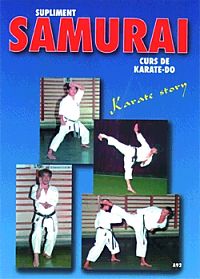 Japanese Language online course. Japanese Language online course.
For information please email us or complete the form in the contact page.
|
|
 |
| |
 Methods of Training for Shotokan Karate, Volume II Methods of Training for Shotokan Karate, Volume II
Author: Neculai Amalinei
A 92 Publishing House, Iasi, 1998.
192 pages, 210x297 mm
ISBN: 973-97928-7-1 |
 |
This is the course of Shotokan Karate Do that was taught to the students attending the University Trainers College, at the Faculty of Physical Education. It has three main chapters.
The first chapter deals with the history of this martial art.
The second chapter develops the general bases, the main principles and the structure of the Karate-Do.
The third chapter presents the fundamentals regarding hand and foot techniques, including fundamental blocks.
The Author
"There are three types of Karate training: Karate for self defense, sport Karate, and Karate Do.
By Karate for self defense, I mean using Martial Arts Techniques to repel (prevent) someone from inflicting bodily injury on oneself.
Sport Karate I believe also uses the above Martial Arts techniques to prevail in competition; however Sport Karate practitioners tend to concentrate on speed and maybe master only one or two techniques for competition.
Karate Do represents a way in the study of this Martial Art, and in my opinion it is a way of life, a direction to follow, to find your destiny.
Karate Do training is more in-depth than the Sport Karate or Karate training, because I believe it should be presented for self development of the students which will last them for life.
The methods of training must be scientific and systematic.
Scientific refers to the body functions i.e. muscles contraction and what the body can do over all to generate the energy or the ultimate power coming from within the center.
Systematic refers to the coordination and unity of the body parts to work together as one unit.
But before we go any further, I want to attribute my knowledge and prowess to my instructors: Master H. Nishyama and H. Kanasawa.
In Karate Do discipline is imperative, respect and courtesy must be exercised by each student.
Without discipline Karate Do training is not possible as Sensei Kanasawa says - "Sport Karate reaches its goal when a few individuals are selected to represent the dojo in competition. This is the group that is representing the dojo's overall reputation or ability in competition."
And in my opinion, this is the extend of the students ultimate goal as in Karate Do the ultimate goal and the final purpose is when the entire class, every student has achieved the self development.
There are many things to learn concerning Karate Do because the human body is difficult to understand sometimes and we can relate some ideas of physics in the body doing certain things to generate the energy and power.
For instance first we must know the definition of Kinesiology. Then we must consider other definition in physical like kinetic energy, centrifugal force, inertia, and aesthetic.
So we take for instance Kinetic energy when we use it in relation to Karate Do training, then we consider using our hips and this also using the hips is in reference to considering the effects of the centrifugal force.
So first we use motion, then understand where energy is coming from, and behind the energy are FORCE or POWER.
But everything considered and very important is BREATHING.
Breathing has a large part in projecting this power.
You must also feel or be able to feel your whole self or your muscles in contracting and relaxing in every execution of a technique. Without these feelings, then it is difficult to understand how the energy or power is projected from inside out.
Karate Do conceptual training is very complicated, it takes time, energy, patience, and sacrifice, because Karate Do training does not end until the self development is achieved.
I myself I am still learning and continuing to research what the body can do to have continuity in Karate Do.
I am afraid I will most likely spend the rest of my life continuing to research in order to roach that goal, but I must also say that this research or learning process will have to require the assistance and teaching of my Sensei, Master H. Nishyama and H. Kanasawa.
In the meantime while not learning from them I must be independent in my research to reach my goal in self development using Karate Do concepts."
Sensei Frank Anderson, 7th Dan
Traditional Shotokan International
|
|
|